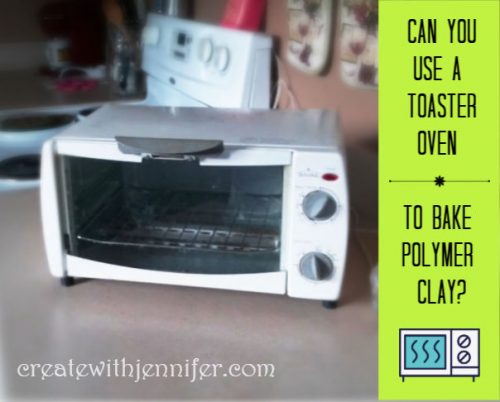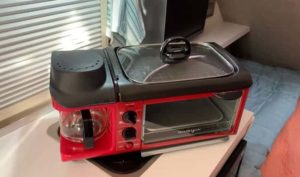A toaster oven can be a useful tool for baking polymer clay, a type of modeling clay that hardens when heated. Polymer clay is commonly used to create jewelry, figurines, and other small decorative items. Using a toaster oven for polymer clay baking is a cost-effective alternative to using a larger, dedicated kiln or oven. Toaster ovens are also compact, making them a convenient option for those with limited workspace. However, it’s important to use the toaster oven safely and to follow specific guidelines for baking polymer clay to achieve the best results.
Can polymer clay be baked in a toaster oven?
Yes, polymer clay can be baked in a toaster oven. In fact, a toaster oven can be a convenient and cost-effective option for baking small polymer clay projects. However, it’s important to note that toaster ovens may have temperature fluctuations or hot spots that can cause uneven baking or burning. To ensure the best results, it’s important to use a thermometer to monitor the temperature of the toaster oven and to place the polymer clay project in the center of the oven to avoid hot spots.
It’s also important to follow the manufacturer’s instructions for baking the specific brand of polymer clay, as different brands may have different temperature and time requirements.
Is it safe to use oven after baking polymer clay?
Yes, it is generally safe to use an oven after baking polymer clay. Once the polymer clay has been properly cured and cooled, it is stable and will not release any harmful chemicals or fumes during future use of the oven.
However, it’s important to note that some ovens may have residual odors or smoke after baking polymer clay, especially if the clay was overcooked or burned. In this case, it’s a good idea to ventilate the area and clean the oven thoroughly before using it for food or other purposes.
Additionally, it’s important to only use ovens that are designated for crafts and polymer clay, and not to use ovens that are also used for cooking food. This will help prevent any potential cross-contamination and ensure that the oven is used safely and appropriately for its intended purpose.
What toaster oven is good for polymer clay?
When it comes to choosing a toaster oven for polymer clay baking, there are a few features to look for:
- Temperature control: A toaster oven with a temperature control setting is essential for baking polymer clay, as it allows you to accurately set and monitor the temperature of the oven.
- Even heating: Look for a toaster oven with a heating element that provides even heat distribution throughout the oven to ensure that your polymer clay bakes evenly.
- Size: Make sure that the toaster oven is large enough to accommodate the size of your polymer clay projects. However, it’s important to note that a smaller toaster oven may be more suitable for precise temperature control and even heating.
- Safety features: Look for a toaster oven with safety features such as automatic shut-off, a timer, and a removable crumb tray.
Some popular toaster ovens for polymer clay baking include the Black+Decker TO1313SBD, Hamilton Beach 31344D, and Oster TSSTTVDFL2. Ultimately, the best toaster oven for polymer clay baking will depend on your specific needs and budget.
What is the best oven to bake polymer clay in?
The best type of oven to bake polymer clay in is a dedicated craft oven, also known as a polymer clay oven or a mini oven. These ovens are designed specifically for baking polymer clay and provide consistent, even heating throughout the oven. Some popular brands of polymer clay ovens include the Sculpey Clay Conditioning Machine, the Amaco Polymer Clay & Craft Oven, and the Paragon QuikFire 6 Kiln.
If you don’t have access to a dedicated polymer clay oven, a regular household oven can also be used. However, it’s important to note that regular ovens may have temperature fluctuations and hot spots that can cause uneven baking or burning of the polymer clay. To ensure the best results when using a regular oven, it’s important to use a thermometer to monitor the temperature and to place the polymer clay project in the center of the oven to avoid hot spots.
Benefits of using toaster oven for polymer clay
There are several benefits to using a toaster oven for polymer clay:
- Cost-effective: A toaster oven is a cost-effective alternative to a full-size oven for baking polymer clay. It is generally less expensive to purchase and operate than a conventional oven.
- Compact size: A toaster oven is smaller in size compared to a conventional oven, making it a great option for those with limited space.
- Precision temperature control: Some toaster ovens come with a digital temperature control feature, which allows for precise temperature settings, which is important for baking polymer clay.
- Quick heating: Toaster ovens heat up quickly, which means less waiting time for the oven to reach the desired temperature.
- Energy-efficient: Toaster ovens are generally more energy-efficient than full-size ovens, which means lower energy bills.
- Versatility: A toaster oven can be used for other crafting and DIY projects in addition to baking polymer clay, making it a versatile tool to have in your workspace.
Overall, using a toaster oven for polymer clay can be a convenient and cost-effective option, especially for those who are new to working with polymer clay or have limited space.
Do you glue polymer clay before baking?
No, you should not use glue to attach pieces of polymer clay together before baking. Polymer clay is designed to bond to itself when it is baked, so glue is not necessary and can actually interfere with the curing process.
Instead of using glue, you can use gentle pressure to attach the pieces of clay together, or you can score the surfaces that will be attached with a sharp tool to create a better bond. You can also use liquid polymer clay as a “glue” by applying a small amount to the surfaces that will be attached before baking.
Once the pieces of polymer clay are attached, gently press them together to ensure a good bond. Be careful not to deform or distort the shape of the clay while doing this.
After baking, the polymer clay will be fully cured and the pieces will be permanently bonded together. If you need to attach additional pieces to the baked clay, you can use liquid polymer clay or other clay-adhesive techniques.
Do you preheat polymer clay in the toaster oven?
No, it is not necessary to preheat polymer clay in a toaster oven. Instead, the toaster oven should be preheated to the temperature specified in the manufacturer’s instructions for the specific brand of polymer clay being used. Once the toaster oven has reached the appropriate temperature, the polymer clay can be placed into the oven to begin the baking process.
It’s important to follow the baking instructions carefully, as overbaking or underbaking the polymer clay can cause it to become brittle or breakable. In general, polymer clay should be baked for 15-30 minutes per 1/4 inch (6mm) of thickness, depending on the specific brand of clay being used. It’s also a good idea to test a small piece of clay before baking a larger project to ensure that the baking time and temperature are appropriate for the specific brand of polymer clay being used.
Factors to consider when choosing the best toaster oven for polymer clay
Here are some factors to consider when choosing the best toaster oven for polymer clay:
- Temperature control: Look for a toaster oven with precise temperature control so that you can ensure that the temperature stays consistent throughout the baking process. Ideally, the oven should have a temperature range of 200°F to 300°F.
- Size: Choose a toaster oven that is large enough to accommodate your polymer clay projects without crowding them. Make sure to measure the interior dimensions of the oven and compare them to the size of your projects before purchasing.
- Heat distribution: Look for a toaster oven that has good heat distribution, so that the clay bakes evenly. Some toaster ovens have a fan or convection feature that helps to circulate the heat evenly.
- Timer: A timer is essential for ensuring that your polymer clay projects are not overcooked or undercooked. Look for a toaster oven with a timer that can be set for the appropriate baking time.
- Easy to clean: Choose a toaster oven that is easy to clean, as polymer clay can leave residue behind. Look for an oven with removable racks or a non-stick interior that can be wiped clean.
- Safety features: Choose a toaster oven with safety features such as automatic shut-off, cool-touch exterior, and an insulated door to prevent accidental burns.
- Brand reputation: Choose a toaster oven from a reputable brand that has a good track record for quality and reliability. Look for reviews and recommendations from other polymer clay artists to find a toaster oven that is well-suited for polymer clay baking.
By considering these factors, you can find a toaster oven that is well-suited for baking polymer clay and that will provide consistent, reliable results.
How to use toaster oven for polymer clay
To use a toaster oven for polymer clay, follow these steps:
- Preheat the toaster oven: Turn on the toaster oven and preheat it to the temperature specified in the manufacturer’s instructions for the specific brand of polymer clay being used.
- Prepare the clay: Sculpt the polymer clay into the desired shape, following the instructions for the specific project being created. Make sure the clay is free of dust or debris.
- Place the clay on a baking surface: Line a baking sheet or tray with parchment paper or aluminum foil. Place the polymer clay on the baking surface, making sure that it is not touching any other pieces of clay or the sides of the toaster oven.
- Bake the clay: Place the baking sheet with the clay into the preheated toaster oven. Set the timer for the recommended baking time, which is usually 15-30 minutes per 1/4 inch (6mm) of thickness, depending on the specific brand of polymer clay being used. Monitor the baking process carefully to avoid overbaking or burning the clay.
- Remove the clay from the oven: Once the baking time is complete, turn off the toaster oven and carefully remove the baking sheet with the polymer clay from the oven. Allow the clay to cool completely before handling it.
Note that toaster ovens may have temperature fluctuations or hot spots that can cause uneven baking or burning, so it’s important to monitor the temperature of the oven using a thermometer. It’s also a good idea to test a small piece of clay before baking a larger project to ensure that the baking time and temperature are appropriate for the specific brand of polymer clay being used.
How long to bake polymer clay in toaster oven?
The baking time for polymer clay in a toaster oven can vary depending on the thickness of the clay and the brand of clay being used. However, a general rule of thumb is to bake polymer clay in a toaster oven at 265°F (130°C) for 15-30 minutes per 1/4 inch (6mm) of thickness.
It’s important to note that the baking time and temperature may vary for different brands of polymer clay, so it’s important to refer to the manufacturer’s instructions for specific baking guidelines.
When baking polymer clay in a toaster oven, it’s also important to monitor the temperature of the oven using a thermometer, as toaster ovens may have temperature fluctuations or hot spots that can cause uneven baking or burning. It’s recommended to preheat the toaster oven to the desired temperature before placing the polymer clay in the oven. After baking, allow the polymer clay to cool completely before handling or painting it.
How do you know if polymer clay is baked properly?
There are a few ways to tell if polymer clay is baked properly:
- Color: Polymer clay will change color as it is baked. It will typically become slightly darker or more translucent than its original color. Follow the manufacturer’s instructions for the specific brand of polymer clay being used.
- Firmness: Polymer clay will become firm when it is properly baked. To test the firmness, gently press the surface of the clay with a finger or a tool. If it is still soft or flexible, it needs more baking time. If it is hard and solid, it has been over-baked.
- Smell: Polymer clay will emit a slightly plastic smell when it is baking. This is normal and expected. However, if the smell is strong or unpleasant, or if the clay is smoking or burning, it may be over-baked or the temperature may be too high.
It’s important to note that different brands and colors of polymer clay may have different baking times and temperatures, so it’s important to refer to the manufacturer’s instructions for specific baking guidelines. It’s also a good idea to test a small piece of clay before baking a larger project to ensure that the baking time and temperature are appropriate for the clay being used.
Troubleshooting about toaster oven for polymer clay
Here are some common troubleshooting tips for using a toaster oven for polymer clay:
- Uneven heating: If your polymer clay project is not baking evenly in the toaster oven, try rotating the pan or project halfway through the baking time to ensure that the clay is exposed to even heat.
- Burning or overbaking: If your polymer clay is burning or overbaking in the toaster oven, it could be due to the oven temperature being too high or the baking time being too long. Always follow the manufacturer’s instructions for baking the specific brand of polymer clay that you are using.
- Color changes: If your polymer clay is changing color during baking, it could be due to the oven temperature being too high or the baking time being too long. Some brands of polymer clay may also darken slightly during baking.
- Fumes: Baking polymer clay can release fumes that may be harmful if inhaled. Always use a well-ventilated area and avoid baking polymer clay in an area where food is prepared or consumed.
- Insufficient baking: If your polymer clay feels soft or flexible after baking, it may not have been baked long enough. Always follow the manufacturer’s instructions for baking time and temperature, and test a small piece of clay before baking larger projects.
- Baked onto the surface: If your polymer clay project is sticking to the baking surface, try using a release agent such as parchment paper or a silicone baking mat.
Remember to always follow the manufacturer’s instructions for baking the specific brand of polymer clay that you are using, and if you encounter any problems or concerns, consult the manufacturer or an experienced polymer clay artist for assistance.
Should you buy toaster oven for polymer clay?
If you are a fan of polymer clay crafting, then buying a toaster oven specifically for baking your creations can be a good investment. A toaster oven can provide a controlled and consistent heat source, making it easier to achieve the desired results for your polymer clay projects. It can also be more energy-efficient than using a full-sized oven.
However, it’s important to note that not all toaster ovens are suitable for baking polymer clay. You need to choose a toaster oven that meets certain criteria, such as precise temperature control, good heat distribution, and safety features. You should also ensure that you follow proper safety precautions when using a toaster oven for polymer clay, such as working in a well-ventilated area and avoiding overheating the clay.
Overall, a toaster oven can be a great tool for polymer clay crafting, but it’s important to choose the right one and use it safely and properly.
Related Posts
How to choose the best toaster oven for elderly
Disclaimer: There are affiliate links in this post. At no...
Read MoreWhat is the best countertop oven for baking cakes?
Disclaimer: There are affiliate links in this post. At no...
Read MoreWhat is the best toaster oven for frozen pizza?
Disclaimer: There are affiliate links in this post. At no...
Read MoreBest Toaster Oven For RV
Disclaimer: There are affiliate links in this post. At no...
Read MoreWhy Trust Us
You will find what you are looking for at dulceriabakery. From classic to luxury brands, you'll find both. We will help you to select appliances that fit your needs, budget and lifestyle. Whether you want to stop by to learn more — or plan to make a major purchase — we’ll treat you like family and assist you every step of the way. Shop with us today to receive friendly and experienced help along the way.





